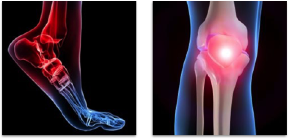
Jordi Sanchez-Ballester
FRCSEd FRCS Trauma & Orth
Consultant Foot, Ankle & Knee Surgeon
Fairfield Independent Hospital, St Helens
Spire Cheshire
Bone-Surgeon.co.uk
Fairfield Independent Hospital
Crank Rd
St Helens
Merseyside WA11 7RS
01744 739311
Spire Cheshire Hospital
Chris Davies
Fir Tree Close
Warrington WA4 4LU
0845 602 2500
Bunions (Hallux Valgus Deformity)
Bunions are bony lumps that develop on the side of your foot and at the base of your big toe. They’re the result of a condition called hallux valgus, which causes your big toe joint to bend towards the other toes and become deformed. If symptoms carry on over a long period, your toe may need to be surgically corrected.
This involves straightening your big toe and metatarsals, a process called an osteotomy. Although this may make your joint stiffer, it works to ease the pain.
Most surgery can be performed as a day case and takes up to an hour. Your foot will be bandaged and you’ll need to wear a Velcro surgical shoe for four to six weeks afterwards. If your bunion has been caused by rheumatoid arthritis, you may also develop rheumatoid nodules.
These firm, pea-sized lumps can occur at pressure points such as your big toe joints, the back of your heels or on your toes, but they can be surgically removed.
Sometimes swellings or bursae on the joints in your feet are also called bunions, but these aren’t the same as bunions caused by hallux valgus and don’t need surgery. Hallux valgus is different to hallux rigidus, which is osteoarthritis of the big toe joint.
Bunion Diagnosis
It is necessary to take an x-ray in order to determine the extent of the bunion and any associated arthritis.
Bunion Treatment
Non-surgical bunion treatment
Around half of all bunion sufferers do not need surgery. The goal of non-surgical treatment is to relieve pressure on the foot and to prevent the development of pressure sores and ulcers.
In some cases, comfortable, well-fitted shoes are sufficient to alleviate pain. A podiatrist can prescribe an orthotic, which is a device inserted into the shoe to prevent the condition from worsening.
It is very important to address any abnormalities in biomechanics. This term refers to foot and lower leg posture during movement.
We offer an integrated, multi-disciplinary approach, with specialist foot and ankle surgeons working closely with podiatrists and physiotherapists.
Surgical Treatment
Bunion surgery is the only way to correct the deformity of Hallux valgus and restore “normality” to the big toe, not only in terms of appearances but also in terms of function.
Unfortunately bunion surgery has a reputation for being very painful. This is because many older techniques involved destroying the big toe joint and not using any form of fixation when the bones were cut.
This would therefore mimic a fracture and not surprisingly caused considerable pain and a long period of recovery.
However, there are many modern types of bunion surgery available now which are more sophisticated and for each patient undergoing bunion surgery there will be an optimal procedure based on the extent of the deformity but also on the lifestyle of the patient.
Surgical Techniques
We regularly use a procedure called the Scarf Osteotomy. This is a well-established procedure which allows correction of deformity and simultaneous preservation of the normal foot anatomy.
We also offer a new form of minimally invasive bunion surgery based on much smaller incisions and reduced scarring, which appears to offer a quicker and easier recovery.
We only offer this technique in mild deformities.